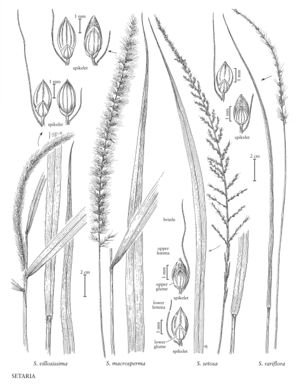Difference between revisions of "Setaria setosa"
FNA>Volume Importer |
imported>Volume Importer |
||
| Line 4: | Line 4: | ||
|publications= | |publications= | ||
|common_names=West indies bristlegrass | |common_names=West indies bristlegrass | ||
| + | |special_status={{Treatment/ID/Special_status | ||
| + | |code=I | ||
| + | |label=Introduced | ||
| + | }} | ||
|basionyms= | |basionyms= | ||
|synonyms= | |synonyms= | ||
| Line 38: | Line 42: | ||
|publication title= | |publication title= | ||
|publication year= | |publication year= | ||
| − | |special status= | + | |special status=Introduced |
| − | |source xml=https:// | + | |source xml=https://bibilujan@bitbucket.org/aafc-mbb/fna-data-curation.git/src/bb6b7e3a7de7d3b7888a1ad48c7fd8f5c722d8d6/coarse_grained_fna_xml/V25/V25_1408.xml |
|subfamily=Poaceae subfam. Panicoideae | |subfamily=Poaceae subfam. Panicoideae | ||
|tribe=Poaceae tribe Paniceae | |tribe=Poaceae tribe Paniceae | ||
Revision as of 22:01, 27 May 2020
Plants perennial. Culms 50-100 cm; nodes usually glabrous. Sheaths glabrous or finely pubescent, margins ciliate distally; ligules of 1 mm hairs; blades 15-20 cm long, 6-12 mm wide, flat or folded, often finely pubescent on both surfaces. Panicles 15-20 cm, loosely spikelike, interrupted, attenuate; rachises often villous; branches ascending, lower branches about 2.5 cm; bristles usually solitary, less than 10 mm, antrorsely scabrous. Spikelets 2-2.5 mm, ovate-lanceolate. Lower glumes about 1/2 as long as the spikelets, 3-veined; upper glumes about 2/3 as long as the spikelets, 5-7-veined; lower lemmas equaling the upper lemmas; lower paleas as long as the upper paleas, broad; upper lemmas finely and distinctly transversely rugose. 2n = unknown.
Distribution
Puerto Rico, N.J., Virgin Islands, Ala., Fla.
Discussion
Setaria setosa is native to the West Indies and Mexico. It is probably a recent introduction to Florida, but appears to be established there. The specimen from New Jersey was from a ballast dump; the species is not established in that state.
Selected References
None.
